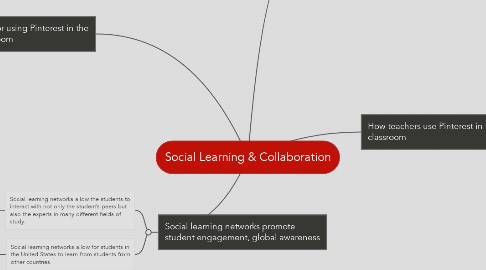
1. How teachers use Pinterest in the classroom
1.1. Some teachers are using Pinterest to organize and plan activities.
1.1.1. For example, one teacher found physical activities for her student to perform out of their seats to allow them to get rid of some of the jitters they have after sitting in their seats for extended periods of time.
1.2. Some teachers are using Pinterest to find ways to communicate with their student’s parents.
1.2.1. For example, on Pinterest, teachers can find editable contact logs that have already been created by other teachers.
2. Tips for using Pinterest in the classroom
2.1. School districts are using Pinterest to organize curriculum material for teachers to use when creating lessons.
2.1.1. For example, a teacher who teaches 2nd grade will be able to go to the 2nd-grade board and find ideas for his or her lesson they are planning to teach.
2.2. There are also colleges that are using Pinterest to showcase student work.
2.2.1. Students can store photos of their work on Pinterest and allow others on Pinterest to see their final product.
3. Social learning networks promote student engagement, global awareness
3.1. Social learning networks allow the students to interact with not only the student’s peers but also the experts in many different fields of study.
3.1.1. For example, students who are interested in learning about space could use a blog to ask questions to people who work for NASA.
3.2. Social learning networks allow for students in the United States to learn from students from other countries.
3.2.1. For example, ePals allows students to have discussions with other students around the world about topics like language, culture, and geography.
4. A Sample Ning Network
4.1. A Ning Network is a way for teachers to create a website based environment, which allows students to interact with students in their classroom using the internet.
4.1.1. For example, teachers can post questions on a Blog and students can then respond to these issues and also respond to other students responses. Therefore, all student engage in the discussion that probably would not happen in a regular classroom setting.

